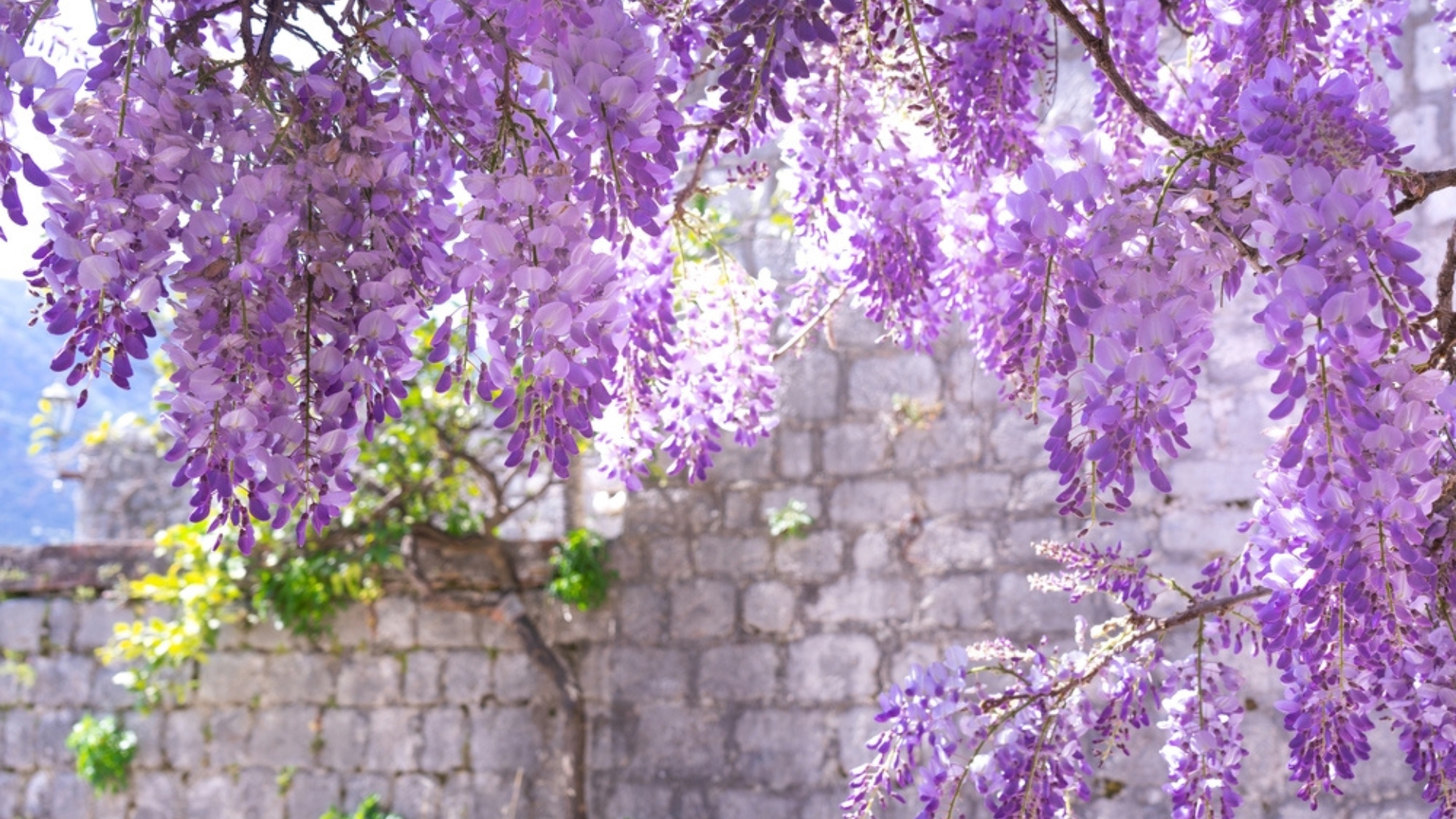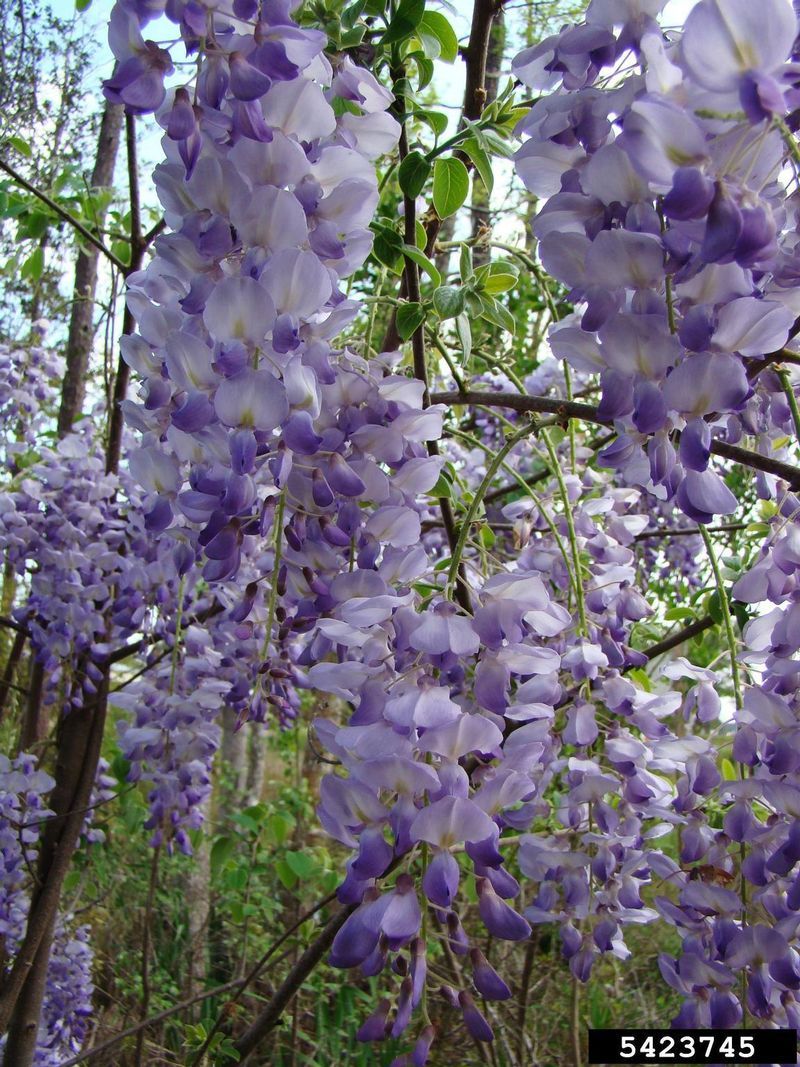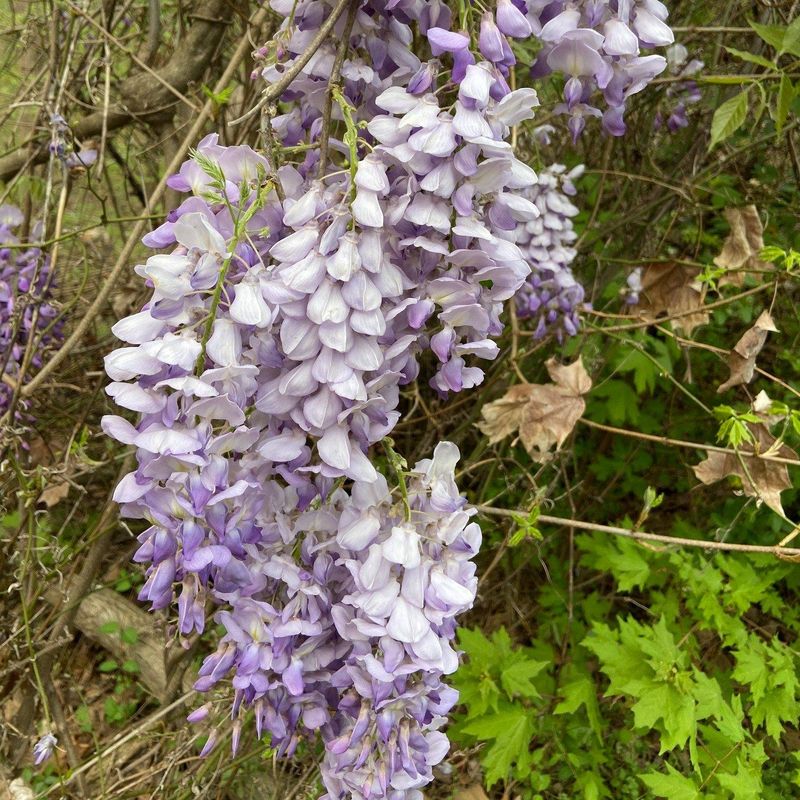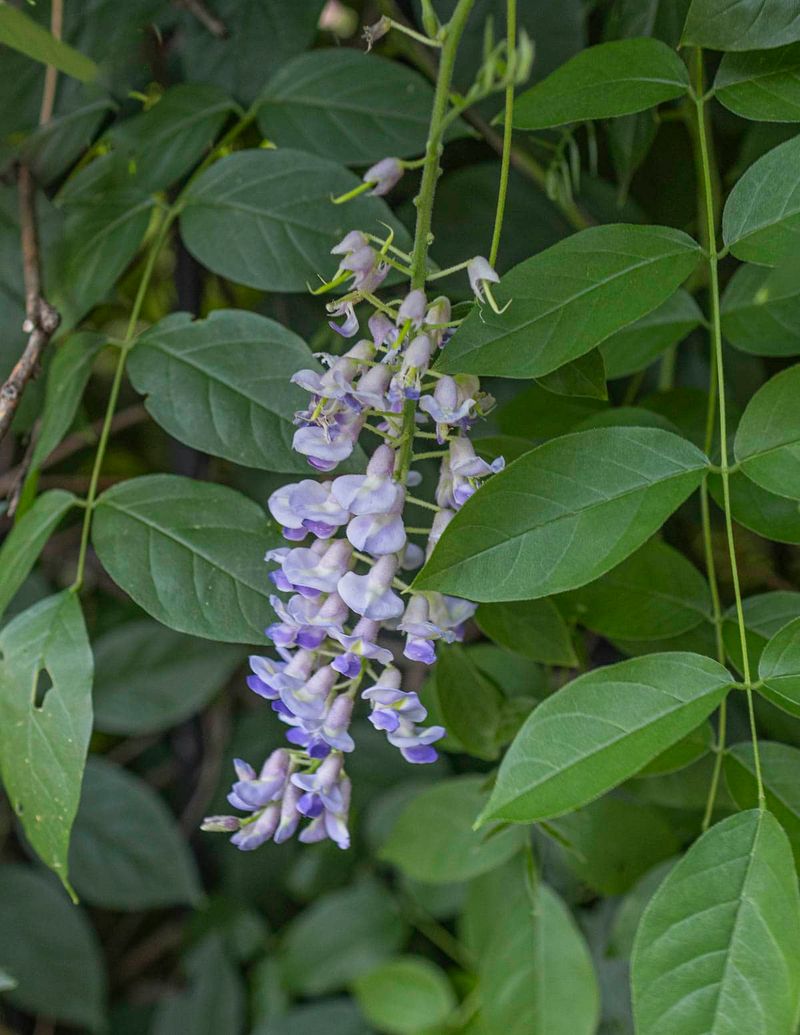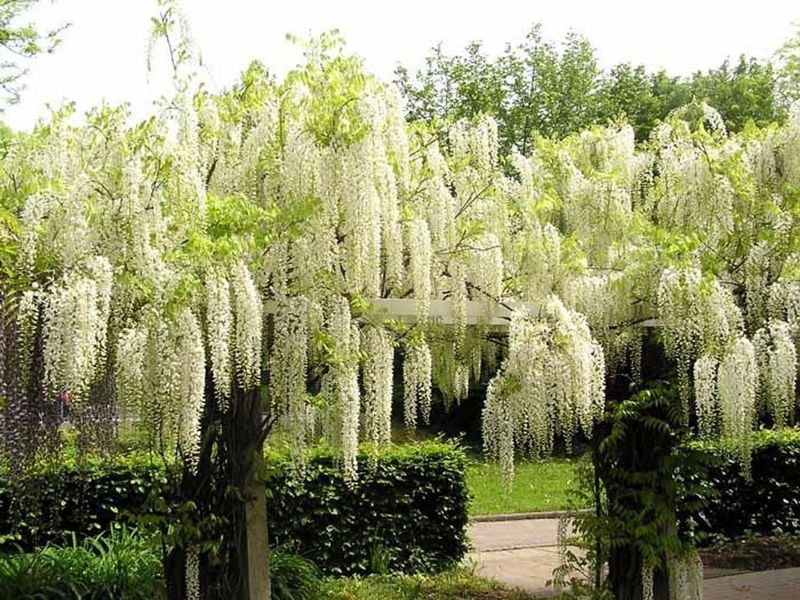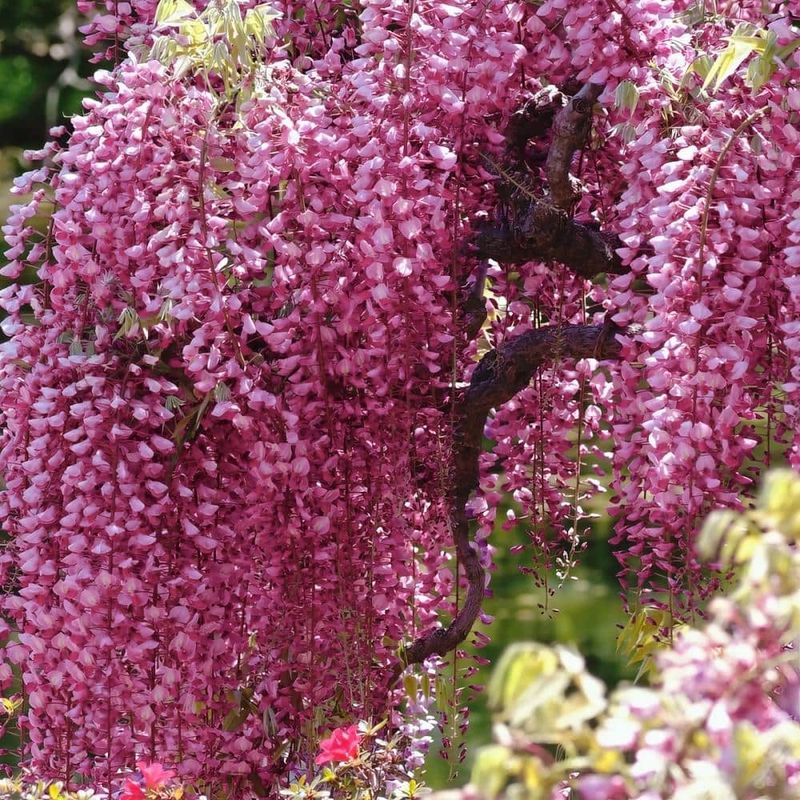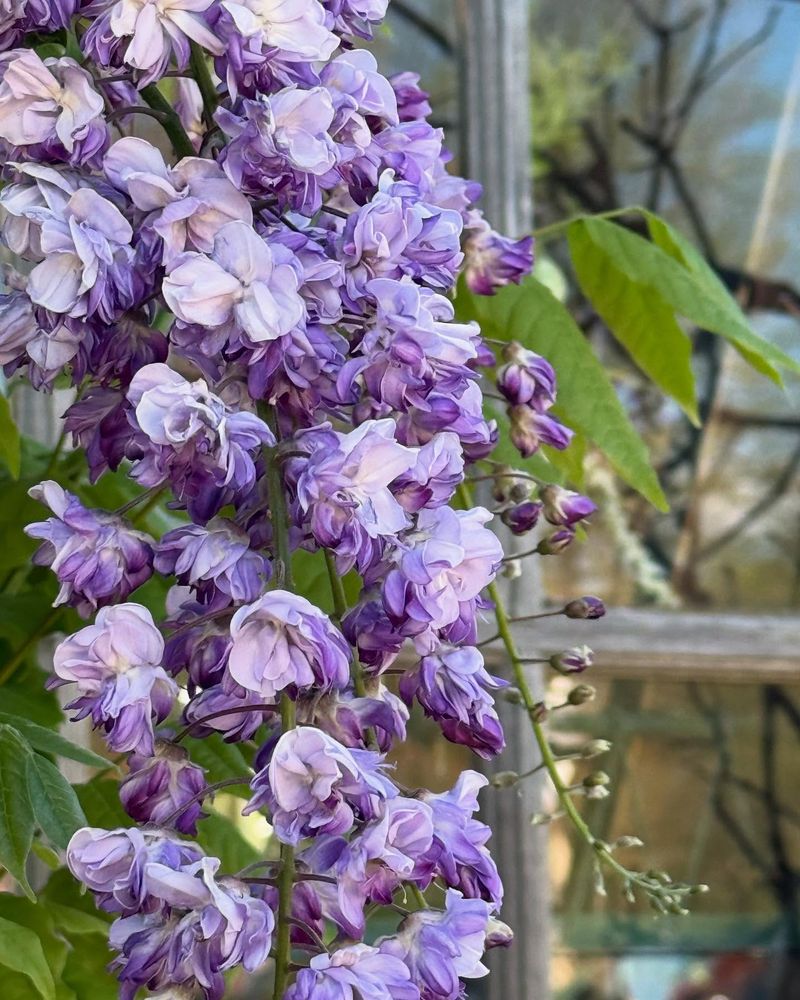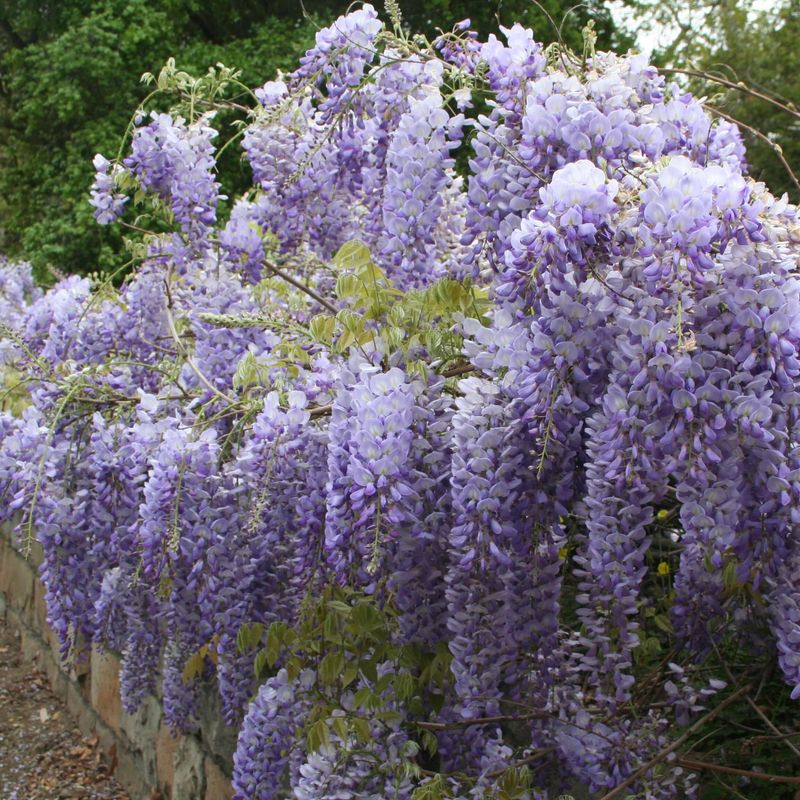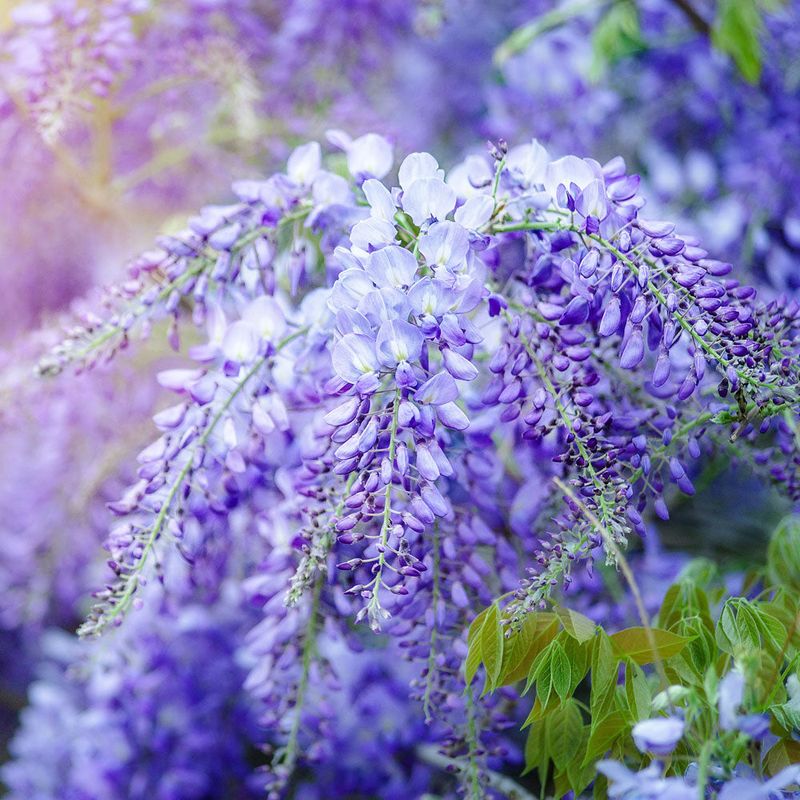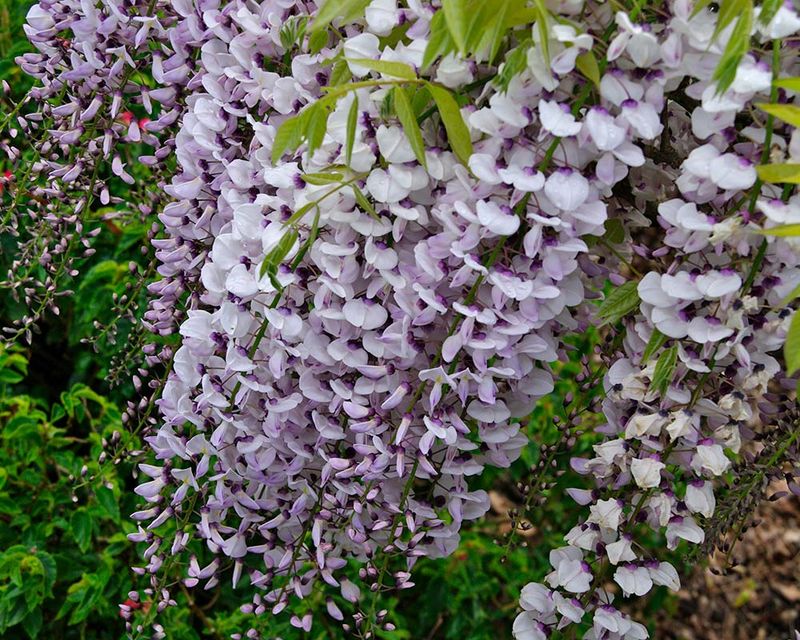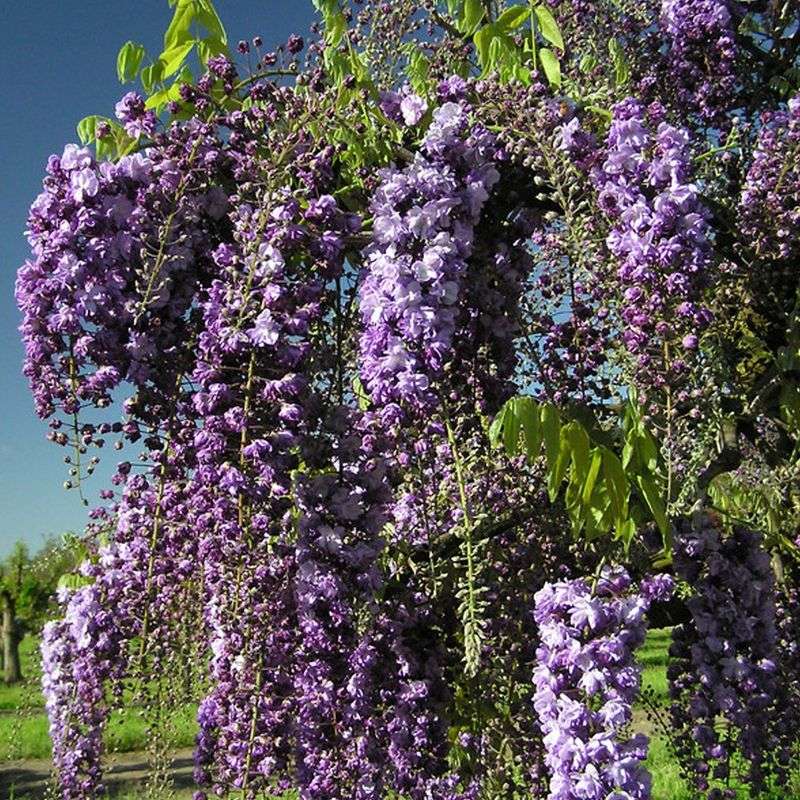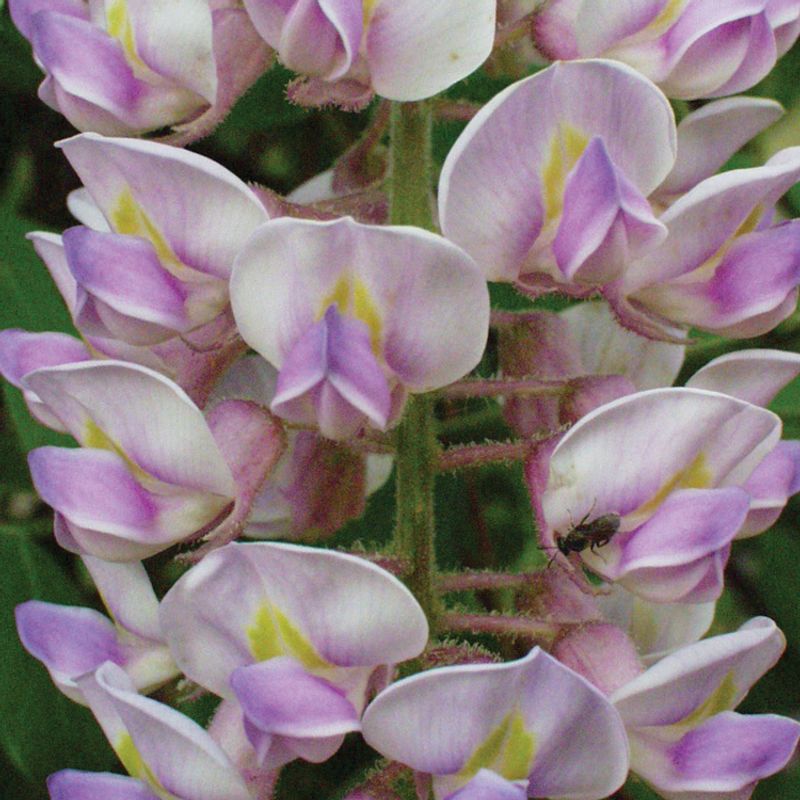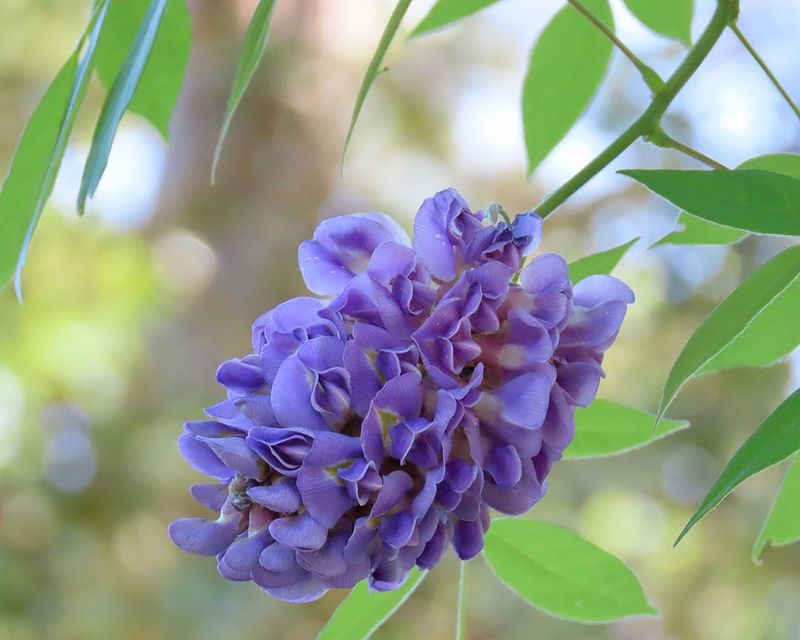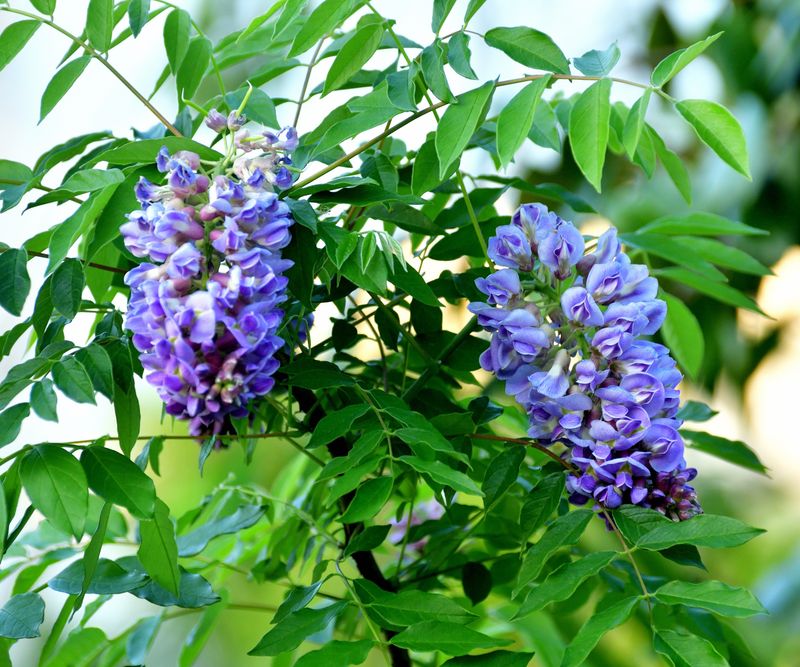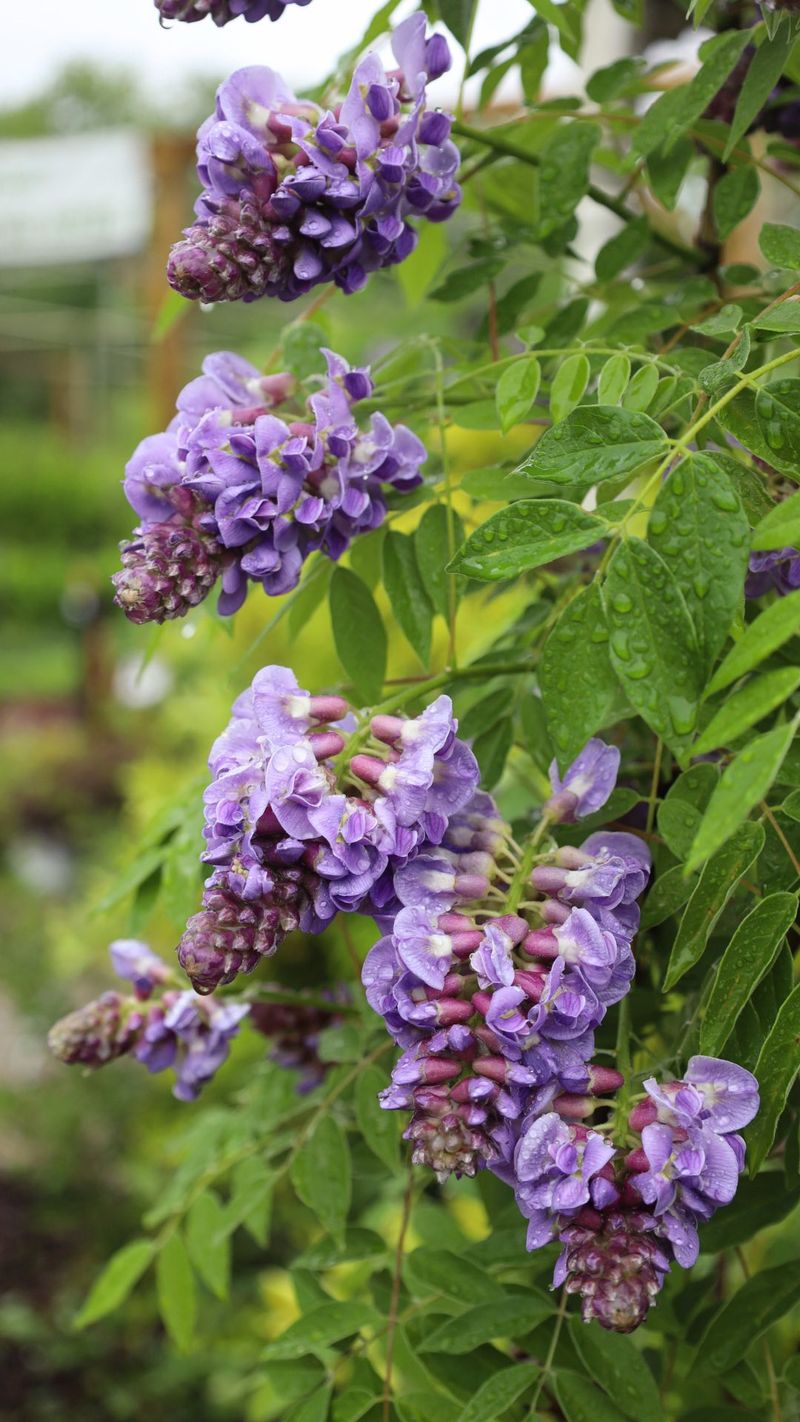Wisteria vines are undeniably stunning—but some varieties come with a wild side. Plant the wrong one, and you could be fighting a fast-spreading takeover instead of enjoying the view.
If you want beauty without the battle, steer clear of these 14 aggressive types—and check out 3 safe alternatives that bring the charm without the chaos.
1. Chinese Wisteria (Wisteria sinensis)
Originally brought to America in the 1800s, Chinese wisteria has become a notorious garden thug. The vine grows at an astonishing rate of 15 feet per year, easily engulfing trees, shrubs, and structures in its path.
The pretty purple flowers hide its aggressive nature. Underground, it develops massive root systems that sprout new plants yards away from the original. States like South Carolina and Georgia now battle huge infestations in their forests where this botanical bully strangles native trees.
2. Japanese Wisteria (Wisteria floribunda)
Gardeners often fall for Japanese wisteria’s spectacular 3-foot flower clusters without realizing the monster they’re welcoming home. This variety twines clockwise around supports, crushing them with woody stems that can reach 6 inches thick.
Birds spread its seeds far and wide after eating the toxic seed pods. Once established, Japanese wisteria forms dense mats that smother native vegetation. The root system becomes nearly impossible to fully remove, with new shoots emerging years after you thought you’d won the battle.
3. Silky Wisteria (Wisteria brachybotrys)
Don’t let the beautiful name fool you! Silky wisteria earns its place on the invasive list with its vigorous growth habit and tendency to escape cultivation. Native to Japan, this variety produces shorter flower clusters but compensates with extremely rapid growth.
The silky-haired leaves might look appealing, but underneath lurks an aggressive root system that sends up suckers everywhere. Garden centers still sell this troublemaker despite its known invasive tendencies. Even in cold northern states, silky wisteria has demonstrated alarming adaptability.
4. White Chinese Wisteria (Wisteria sinensis ‘Alba’)
The albino cousin of regular Chinese wisteria carries all the same invasive traits wrapped in an innocent white package. Garden centers market this variety as an elegant alternative, but don’t be fooled by the color change!
White Chinese wisteria still grows at breakneck speed, produces viable seeds that birds distribute widely, and develops wood strong enough to crack foundations and topple fences. The pale flowers may look angelic, but this variety remains a devil in the garden, especially in the southeastern United States.
5. Variegated Japanese Wisteria (Wisteria floribunda ‘Variegata’)
Fancy foliage doesn’t make this wisteria any less aggressive. The variegated leaves with creamy white edges add extra visual appeal, tricking gardeners into thinking it’s a special, well-behaved variety.
Unfortunately, the pretty leaves sit on the same rampant vines that can grow 10+ feet annually. The roots still travel far from the original planting site, sprouting new plants that quickly revert to solid green foliage. Once established, even professional landscapers struggle to completely eradicate this botanical menace.
6. Pink Japanese Wisteria (Wisteria floribunda ‘Rosea’)
The rosy-pink flowers of this Japanese wisteria cultivar lure unsuspecting gardeners with their unusual color. Garden centers charge premium prices for this variety, rarely mentioning its aggressive tendencies.
Like its purple cousin, ‘Rosea’ produces masses of seeds that germinate readily. The roots are equally invasive, traveling underground and sprouting dozens of feet from the parent plant. In just a few years, this pretty pink monster can engulf an entire garden, with stems thick enough to pull down gutters and fencing.
7. Double-Flowered Wisteria (Wisteria floribunda ‘Violacea Plena’)
Double the flowers means double the trouble with this extra-showy Japanese wisteria variety. The fuller blooms entice collectors who don’t realize they’re bringing home an aggressive invader that will quickly outgrow its welcome.
The double flowers produce slightly fewer seeds, but the plant compensates with even more aggressive root spread. Garden centers rarely mention that those beautiful blooms are attached to vines that can crack concrete and crush arbors. Like other Japanese varieties, it’s particularly problematic throughout the eastern United States.
8. Early-Blooming Chinese Wisteria (Wisteria sinensis ‘Prolific’)
Marketing this variety as ‘Prolific’ should be your first warning sign! This early-blooming Chinese wisteria lives up to its name by producing abundant flowers and, unfortunately, abundant growth in all directions.
Blooming earlier than other varieties means it has a longer growing season to spread its tendrils. The early flowers also mean early seed production, giving birds more time to distribute them throughout your neighborhood. Despite its popularity in garden centers, this variety has contributed to serious wisteria invasions in natural areas.
9. Blue Japanese Wisteria (Wisteria floribunda ‘Royal Purple’)
The intense blue-purple blooms of ‘Royal Purple’ make it a garden center favorite, but this regal beauty quickly becomes a royal pain. Gardeners seduced by its color often underestimate how quickly it will colonize their yard.
The exceptionally long flower clusters—sometimes reaching four feet—hide the aggressive nature of the stems and roots. Like other Japanese varieties, ‘Royal Purple’ can grow 15+ feet per year once established. The thick, woody vines have been known to lift shingles off roofs and even pull down small trees.
10. Hybrid Wisteria (Wisteria × formosa)
When Chinese and Japanese wisteria cross-pollinate, they create a super-aggressive hybrid combining the worst traits of both parents. These hybrids often appear in nurseries without clear labeling about their invasive potential.
Hybrid vigor gives these plants extra growing power, with vines that can reach 25 feet in a single season under ideal conditions. The flowers bloom somewhere between the timing of the two parent species, extending the period when pollinators visit. Unfortunately, this leads to abundant seed production and rapid spread.
11. Golden Japanese Wisteria (Wisteria floribunda ‘Shiro Noda’)
The creamy yellow flowers of this Japanese wisteria variety stand out in garden catalogs, but its invasive habits match its purple-flowered relatives. Garden centers market this as a rare collector’s plant, often at premium prices.
Despite the color difference, ‘Shiro Noda’ produces the same aggressive underground runners that can emerge dozens of feet from the parent plant. The woody vines grow just as quickly and become just as strong. Many gardeners have discovered too late that this golden beauty quickly turns into a golden nightmare.
12. Winter-Flowering Wisteria (Wisteria brachybotrys ‘Okayama’)
Winter-flowering varieties like ‘Okayama’ tempt gardeners with the promise of off-season blooms, but they bring the same invasive headaches. This Japanese silky wisteria cultivar has adapted to produce flowers earlier than most varieties.
The unusual blooming time doesn’t make it any less aggressive. The root system still sends up suckers throughout the garden, and the vines grow just as quickly as summer-blooming types. Gardeners in mild-winter areas have reported this variety becoming particularly problematic as it can grow nearly year-round.
13. Black Dragon Wisteria (Wisteria floribunda ‘Black Dragon’)
The darkest purple flowers in the wisteria world belong to ‘Black Dragon,’ a Japanese variety that looks dramatic but behaves badly. The double flowers and deep color make it highly sought after by collectors who often don’t understand its invasive nature.
Despite its special appearance, Black Dragon grows just as aggressively as other Japanese wisterias. The vines quickly become woody and strong enough to damage structures. Its root system spreads underground, popping up new plants that can appear 50 or more feet from the original.
14. Texas Wisteria (Wisteria frutescens var. macrostachya)
While not as aggressive as Asian varieties, the Texas wisteria (a type of American wisteria) can still become invasive outside its native range. Its shorter flower clusters don’t attract as much attention, but it compensates with faster growth than typical American wisteria.
Garden centers often mislabel this as a “well-behaved” alternative without mentioning its spreading tendency in favorable conditions. Though not as problematic as Chinese or Japanese types, Texas wisteria has escaped cultivation in several states and can crowd out native vegetation when it establishes in natural areas.
15. American Wisteria (Wisteria frutescens)
Finally, a wisteria you can actually plant! Native to the eastern United States, American wisteria offers beautiful purple-blue flower clusters without the aggressive tendencies of its Asian cousins.
Growing at a manageable rate of 3-5 feet per year, American wisteria won’t overwhelm your garden. The flower clusters are shorter but still beautiful, typically appearing after the leaves emerge. Best of all, this variety rarely produces suckers from its roots, making it much easier to keep in bounds.
16. Kentucky Wisteria (Wisteria macrostachya)
Another excellent native option, Kentucky wisteria combines the best traits of ornamental wisterias without the invasive downsides. This North American native produces beautiful blue-purple flowers on vines that know their place in the garden.
Kentucky wisteria grows moderately at 8-10 feet per year, allowing you to enjoy its beauty without constant pruning battles. It flowers reliably even in colder climates (down to zone 4), often blooming twice in a season. The scent is lighter than Asian varieties but still delightful.
17. Amethyst Falls Wisteria (Wisteria frutescens ‘Amethyst Falls’)
Garden designers love ‘Amethyst Falls’ for its compact growth and reliable flowering, even when young. This cultivar of American wisteria stays smaller than other varieties, making it perfect for small gardens and containers.
‘Amethyst Falls’ typically grows just 8-10 feet tall, compared to the 30+ feet of Asian types. The lavender-blue flower clusters appear in late spring and often repeat bloom throughout summer. Unlike its invasive cousins, this well-mannered variety won’t send up suckers everywhere or strangle neighboring plants.

